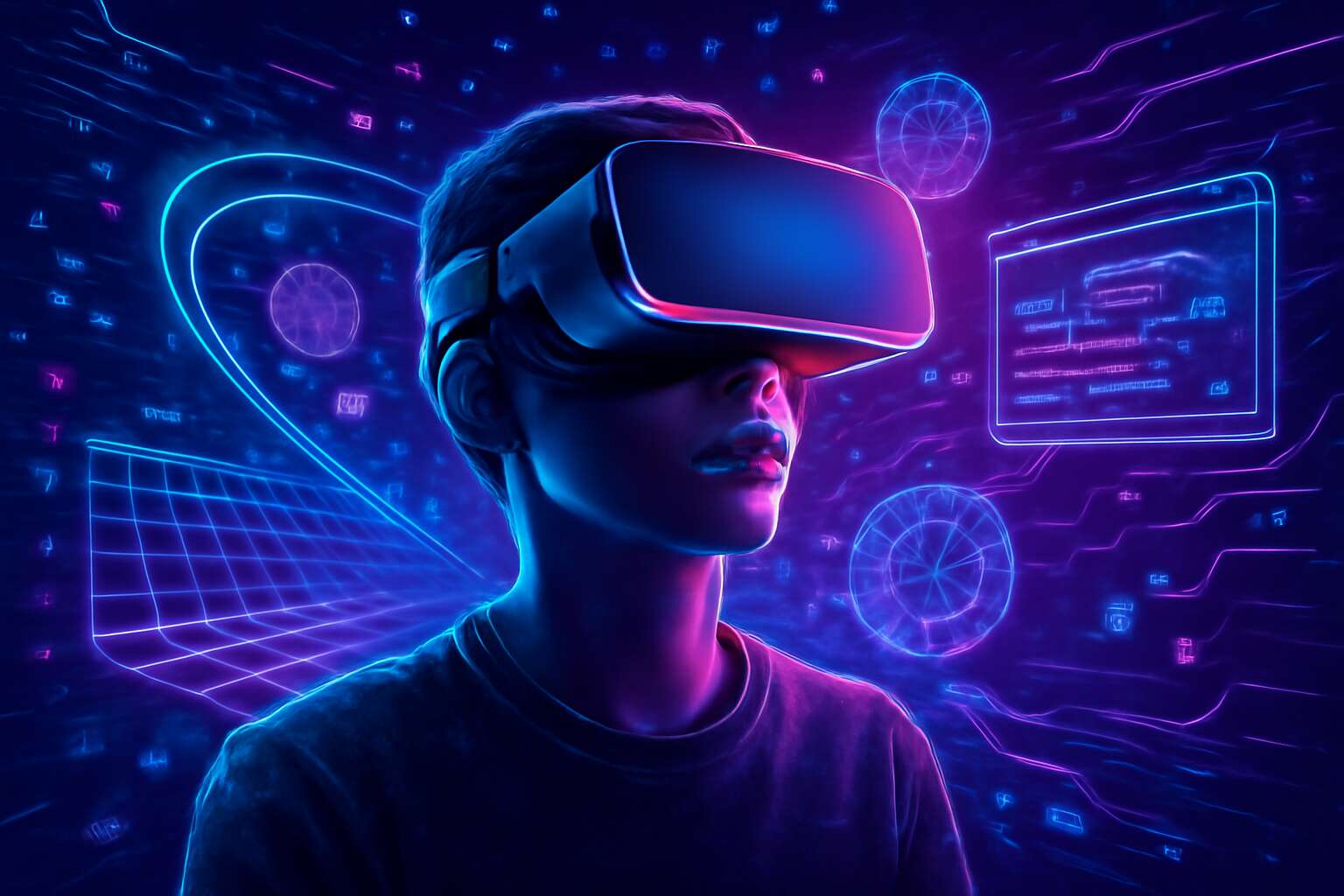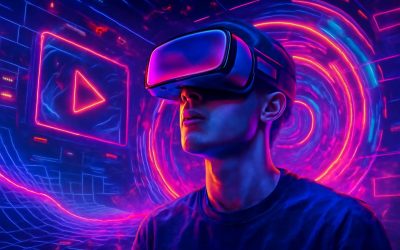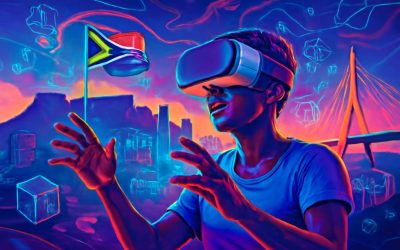Understanding Virtual Reality in Computing
Definition of Virtual Reality – Explaining what virtual reality is in the context of computers
Imagine slipping into a digital world so convincing that it feels as real as your morning coffee—except you’re not actually spilling it on your keyboard. That, in essence, is what is virtual reality in computer, a technological marvel that transports users beyond the confines of physical space. Virtual reality (VR) immerses you in a simulated environment, often with the help of a headset, motion controllers, and a dash of tech wizardry. It’s like stepping into a sci-fi movie, only this time, you’re the star navigating through digital landscapes.
What makes VR truly fascinating is its versatility. From gaming and training simulations to virtual tours of South African landmarks, the applications are as diverse as the country’s wildlife. At its core, understanding what is virtual reality in computer hinges on the ability to create a convincing illusion of presence. Here’s a quick breakdown:
- High-resolution displays that mimic real-world visuals
- Motion tracking to reflect your movements accurately
- Audio components that adapt to your environment
All these elements combine to offer an experience so immersive it’s easy to forget you’re staring at a screen—making VR a game-changer in the realm of digital interaction. Whether for entertainment, education, or enterprise innovation, virtual reality is transforming how we perceive and interact with digital content, right here in South Africa and beyond.
Historical Development of Virtual Reality – Overview of the evolution of virtual reality technology
The journey of virtual reality in computing is a fascinating tale of innovation and persistence. From the early days of basic head-mounted displays to today’s sophisticated VR systems, this technology has evolved remarkably over the decades. Initially, virtual reality was primarily a research concept, with limited practical applications. However, by the late 20th century, breakthroughs in graphics processing and motion tracking began to shift VR from science fiction to reality.
Throughout this evolution, several milestones stand out. The 1990s saw the release of some of the first commercial VR headsets, though their limited resolution and high costs kept mainstream adoption at bay. It wasn’t until the 2010s that virtual reality in computer technology truly took off, driven by major players like Oculus Rift, HTC Vive, and PlayStation VR. These developments made VR more accessible, affordable, and immersive than ever before.
Today, understanding what is virtual reality in computer involves recognizing these technological leaps. The integration of high-resolution displays, precise motion tracking, and spatial audio has transformed virtual reality into a tool that’s not just for gaming but also for training, education, and virtual tours. The evolution continues, promising even more immersive experiences and wider applications for all users, including those right here in South Africa.
Key Components of Virtual Reality Systems – Hardware and software essentials for VR
Understanding what is virtual reality in computer hinges on appreciating its core components—both hardware and software—that breathe life into immersive experiences. At the heart of every virtual reality system lies a symphony of precision-engineered devices designed to transport users to alternate realities. These components work in harmony, creating a seamless bridge between the digital and physical worlds.
On the hardware front, high-resolution displays, motion sensors, and haptic feedback devices form the foundation of any compelling VR setup. The displays—often in the form of head-mounted displays (HMDs)—deliver crisp visuals that captivate the eye, while sensors track every head movement with remarkable accuracy. Meanwhile, specialized controllers and gloves enable users to interact naturally within virtual environments, heightening the sense of presence.
Complementing this hardware ensemble is sophisticated software—programs that render 3D environments, manage motion tracking, and facilitate user interaction. These software engines are responsible for creating realistic spatial audio, dynamic environments, and intuitive user interfaces. For example,
- VR development platforms like Unity and Unreal Engine
are instrumental in crafting immersive worlds, making the experience as fluid as it is captivating.
In essence, the magic of what is virtual reality in computer lies in this intricate dance of hardware and software—each element essential in shaping the future of immersive technology. As South Africa and beyond embrace these innovations, the potential for VR to revolutionize training, entertainment, and education becomes ever more palpable.
How Virtual Reality Works in Computers
Hardware Devices Used in VR – VR headsets, controllers, sensors, and more
Understanding what is virtual reality in computer systems involves delving into the intricate hardware that brings these immersive worlds to life. At the core are VR headsets—devices that transport users into alternate realities with stunning visual displays and spatial audio. These headsets are often equipped with high-resolution screens and advanced sensors that track head movements, creating a seamless experience that reacts in real-time. Complementing the headsets are controllers, which serve as the user’s hands within the virtual environment, translating gestures into digital actions with remarkable precision.
But the magic doesn’t stop there. Sensors placed throughout the room or embedded within the headset itself detect the user’s position and orientation, ensuring total immersion. To enhance realism, some VR systems include haptic feedback devices that simulate touch or resistance, heightening sensory engagement. Here’s a quick overview of the essential hardware involved:
- VR headsets with integrated displays and sensors
- Motion controllers or gloves with tracking capabilities
- External sensors or cameras for spatial awareness
- Haptic feedback devices for tactile interaction
All these components work synergistically, transforming what is virtual reality in computer into a truly immersive experience, where technology blurs the line between digital and physical worlds with astonishing fidelity.
Software Elements and Platforms – VR software, engines, and applications
Understanding what is virtual reality in computer isn’t just about the hardware; it’s also about the sophisticated software that powers these immersive worlds. At the heart of VR software are platforms and engines that serve as the digital scaffolding for creating, rendering, and managing virtual environments. These engines are akin to the brain behind the operation, translating user movements into real-time visual and auditory feedback.
Popular VR platforms such as Unity and Unreal Engine have revolutionized how developers craft immersive experiences. They offer a suite of tools—rendering pipelines, physics simulations, and animation systems—that make virtual worlds feel startlingly real. Think of these software elements as the puppeteers pulling the strings behind the scenes, ensuring every gesture, sound, and visual aligns perfectly with user expectations.
For seamless interaction, VR applications also rely on specialized software that tracks controllers and sensors, translating physical actions into digital commands. As a result, users can navigate complex virtual landscapes or manipulate objects—sometimes with the precision of a master craftsman, other times with the grace of a drunken ballet dancer. Here’s a quick rundown:
- VR-specific operating systems and middleware
- Development engines like Unity and Unreal Engine
- Application software tailored for training, gaming, or education
All these software components work harmoniously, transforming what is virtual reality in computer into an experience so convincing it’s almost magical—leaving users questioning whether they’ve stepped into a digital universe or just experienced a really good simulation!
The Role of Graphics and Rendering – 3D modeling, real-time rendering, and immersion
Understanding how virtual reality works in computers reveals a fascinating blend of technology and artistry. At its core, graphics and rendering are the engines that bring virtual worlds to life, making the impossible seem real. When you wear a VR headset, you’re experiencing real-time rendering—images generated on the fly based on your movements and interactions.
This process relies heavily on 3D modeling, which creates the detailed objects and environments you see. The rendering engine then translates these models into images that change dynamically as you look around or move through the space. It’s this seamless interplay that immerses users, blurring the line between digital and physical worlds.
Immersion depends on high-quality graphics and sophisticated rendering pipelines. These pipelines process countless calculations per second to produce smooth visuals, realistic lighting, and shadows. When combined with spatial audio and tracking sensors, the experience becomes startlingly convincing. It’s no exaggeration to say that understanding what is virtual reality in computer hinges on these visual and sensory components working in perfect harmony.
Types of Virtual Reality in Computer Technology
Non-Immersive VR – Desktop and monitor-based VR experiences
When pondering what is virtual reality in computer, most envision swooping through digital landscapes or battling alien armies in immersive worlds. But not all VR is created equal. Enter non-immersive VR—where the magic happens on your desktop, monitor, or even your laptop screen. Yes, you can explore 3D environments, manipulate objects, or even train for complex tasks, all from the comfort of your chair, without the need for bulky headsets or sensory overload.
Non-immersive VR offers a more accessible approach to virtual reality in computer, making it perfect for educational purposes, design prototypes, or even casual gaming. This type of VR relies heavily on traditional input devices like keyboards, mice, or game controllers. It’s like having a window into a digital universe, but without the full-body immersion. For many, this is the first step into the virtual realm—think of it as VR’s more laid-back cousin who prefers a good book over skydiving in the metaverse.
Semi-Immersive VR – Projection-based and large screen setups
Semi-immersive VR bridges the gap between full immersion and simple desktop experiences, offering a captivating middle ground. Imagine projecting vivid 3D environments onto large screens or even curved surfaces that envelop your vision, creating an expansive digital canvas. This setup transforms a standard conference room or laboratory into a virtual arena, all without the encumbrance of bulky headsets.
For many applications—be it immersive training simulations, architectural visualizations, or collaborative design reviews—semi-immersive VR delivers an impressive level of engagement. It’s like stepping into a digital universe through a giant window, where spatial relationships and scale are more intuitive. This form of virtual reality in computer technology harnesses high-resolution projectors, specialized large screens, and sometimes even interactive touch surfaces to maximize realism and interaction.
Interestingly, this type of VR often employs large-screen projection systems or immersive domes that surround the user with visuals, delivering a sense of presence without requiring full-body tracking or head-mounted displays. For those seeking a more communal or cost-effective approach to virtual reality, semi-immersive setups are an ideal choice—combining visual grandeur with practical accessibility.
Fully Immersive VR – Head-mounted displays and motion tracking
Fully immersive virtual reality in computer technology transports users into a different realm altogether, blurring the line between digital and physical worlds. Through the use of advanced head-mounted displays (HMDs), users are greeted with a 360-degree visual experience that practically engulfs their senses. These headsets, often equipped with motion tracking sensors, interpret every tilt, turn, or nod, ensuring that the virtual environment responds seamlessly to real-world movements. Imagine stepping into a virtual boardroom or a simulated construction site—your body becomes an integral part of the digital landscape.
To enhance the realism further, some systems incorporate hand controllers or even full-body tracking, allowing for natural gestures and interactions. This level of sophistication creates a truly immersive experience where users forget they are in a physical space altogether. Whether used for gaming, training, or design, fully immersive VR in computer technology exemplifies the pinnacle of modern virtual reality, offering an unparalleled sense of presence and engagement.
Applications of Virtual Reality in Computing
Gaming and Entertainment – VR gaming, virtual concerts, and movie experiences
Virtual reality has transcended beyond gaming to revolutionize the way we experience entertainment. In South Africa, VR gaming has gained remarkable popularity, offering players immersive worlds where they can interact with digital environments as if they were real. The thrill of stepping into a fantasy realm or battling zombies in a fully immersive VR game exemplifies how virtual reality enhances entertainment experiences.
Moreover, virtual reality is transforming live events through virtual concerts and movie experiences, bridging geographical divides. Audiences can now attend a concert in Cape Town or watch a blockbuster film from their living room, all through VR platforms. This evolution offers unprecedented access and personalization, making entertainment more engaging and accessible than ever before.
Some applications include:
- Virtual concerts that allow fans to experience their favorite artists in a simulated, intimate setting.
- Immersive movies where viewers can explore scenes in 360 degrees, heightening emotional connection.
- VR gaming that pushes the boundaries of traditional gameplay, creating realistic scenarios and interactive storytelling.
As technology continues to advance, what is virtual reality in computer becomes an increasingly vital component of the entertainment industry, promising even more innovative and captivating experiences in the future.
Training and Education – Simulations for skill development and learning
Virtual reality in computing has opened new horizons for skill development and education, transforming traditional learning paradigms into immersive experiences. By simulating real-world scenarios, VR enables learners to acquire practical skills in a safe, controlled environment. This technology is particularly invaluable in fields such as medicine, engineering, and aviation, where hands-on experience is crucial but often costly or risky to obtain.
One of the most compelling applications of what is virtual reality in computer is the creation of realistic simulations. For example, medical students can perform virtual surgeries, honing their techniques without endangering patients. Similarly, aspiring pilots can practice flying in a virtual cockpit, gaining confidence and competence before stepping into actual aircraft. Such simulations offer a blend of visual fidelity and interactive engagement, making learning both effective and captivating.
In South Africa, educational institutions and training centers increasingly leverage VR to bridge gaps in traditional education. These applications include:
- Interactive virtual labs for science and chemistry experiments
- Simulated driving and transportation training for emerging drivers
- Historical reconstructions that bring South Africa’s rich heritage to life
With advances in graphics rendering and real-time interaction, the potential of virtual reality in computer-based education continues to expand. It transforms passive learning into an active journey, fostering deeper understanding and retention. As this technology evolves, the line between education and experiential discovery blurs, promising a future where knowledge is both accessible and profoundly engaging.
Healthcare and Therapy – VR for pain management, therapy, and surgical training
In the realm of healthcare and therapy, virtual reality in computing is revolutionizing how we approach treatment and skill development. Its application in pain management offers patients an immersive escape from discomfort, reducing reliance on pharmaceuticals and fostering faster recovery. For example, VR environments can distract patients during painful procedures or physical therapy sessions, making the experience less daunting.
Beyond pain relief, virtual reality in computer has become a powerful tool for therapeutic interventions. It enables individuals to confront phobias, manage anxiety, or improve mental health through controlled, virtual exposure therapy. For instance, patients with fear of heights can gradually acclimate to their fears within a safe, simulated setting. This approach has shown promising results across many psychological conditions.
Moreover, VR is transforming surgical training and rehearsal. Aspiring surgeons can practice complex procedures in a realistic virtual setting, sharpening their skills without risk to patients. These simulated experiences foster confidence and precision, crucial in high-stakes environments. As the technology advances, the potential of what is virtual reality in computer for healthcare continues to expand, promising a future where healing and learning are more accessible and profoundly personal.
Industrial and Business Uses – Design visualization, virtual meetings, and remote collaboration
In the fast-paced world of industry and business, virtual reality in computing is transforming how companies operate and innovate. One of its most exciting applications is in design visualization, allowing stakeholders to walk through 3D models of products or architectural plans before a single brick is laid. This immersive approach reduces costly errors and accelerates decision-making, making it a game-changer for architects and engineers alike.
Virtual meetings and remote collaboration have also taken a leap forward, especially in regions like South Africa where global connectivity is vital. Using VR platforms, teams can meet in a virtual conference room, interact with digital models, and brainstorm as if they were in the same physical space. This not only saves time and travel costs but also enhances engagement and productivity.
To maximize efficiency, some organizations adopt
- virtual reality-based training modules
- virtual prototyping
- remote troubleshooting
—all leveraging what is virtual reality in computer to streamline workflows and foster innovation. As this technology continues to evolve, it promises a future where business operations become more dynamic, immersive, and interconnected than ever before.
Advantages and Challenges of Virtual Reality in Computers
Benefits of Using VR – Enhanced engagement, realistic simulations, and innovative experiences
Virtual reality in computers has transformed how we perceive digital worlds, offering an experience that feels startlingly real. The advantages of using VR are profound, especially in creating highly immersive environments that captivate users. Enhanced engagement is one of the most significant benefits, as virtual reality transports individuals into entirely new realms, making learning, gaming, or training sessions intensely compelling. This technology fosters realistic simulations that allow users to practice complex skills safely, whether it’s surgical procedures or industrial design. The innovative potential of VR is limitless, opening doors to experiences once thought impossible.
Despite its numerous benefits, the journey of integrating virtual reality into everyday applications isn’t without hurdles. Challenges such as high costs of hardware, motion sickness, and the need for sophisticated software development can hinder widespread adoption. As the technology evolves, developers and researchers continue to address these issues, aiming to make what is virtual reality in computer more accessible and seamless. The continued refinement of graphics, hardware, and user interfaces promises a future where VR becomes even more intuitive and beneficial across various sectors, from healthcare to business. The potential is vast, but the path forward requires overcoming these obstacles to unlock true immersive power.
Current Challenges – Hardware costs, motion sickness, and technical limitations
While virtual reality in computers offers groundbreaking possibilities, it also faces significant hurdles. One of the primary challenges is the high cost of hardware. VR headsets, sensors, and powerful computers can be prohibitively expensive, limiting accessibility for many users. This financial barrier slows down widespread adoption, especially in regions like South Africa where budget constraints are common.
Another obstacle is motion sickness. Many users experience discomfort or nausea during prolonged VR sessions, which can diminish the overall experience. Technical limitations also play a role — current VR systems sometimes struggle with latency issues and graphics rendering, impacting realism and immersion. These challenges highlight that even though what is virtual reality in computer can be impressive, it’s still evolving to become more seamless and user-friendly.
Addressing these issues requires continuous innovation. As hardware costs decrease and software improves, virtual reality technology will become more accessible and comfortable for a broader audience. For now, understanding these current challenges is essential for anyone exploring what is virtual reality in computer and its future potential.
Future Trends in VR Technology – Advancements in hardware, AI, and immersive experiences
As virtual reality in computers continues its meteoric rise, the future promises advancements that could turn sci-fi fantasies into everyday realities. One area to watch is hardware innovation—think lighter, cheaper, and more powerful VR headsets that eliminate the current barriers to entry. Imagine immersive experiences so realistic that you forget you’re actually sitting in your living room in South Africa rather than exploring distant planets or ancient ruins.
Artificial intelligence (AI) is also set to revolutionize what is virtual reality in computer. By enabling smarter, more responsive virtual environments, AI will enhance personalization and interactivity, making VR worlds feel more authentic than ever. For example, AI-driven characters could adapt to your actions—no more scripted dialogues or predictable scenarios. Coupled with advancements in graphics rendering, future VR systems will boast stunning visuals and seamless motion tracking, reducing latency and motion sickness—a common foe of VR enthusiasts.
Furthermore, the integration of these technologies will bring about unparalleled levels of immersion. From virtual concerts tailored to your musical taste to highly detailed training simulations for industries in South Africa, the possibilities are vast. As the industry evolves, expect a wave of innovations that make what is virtual reality in computer not just more accessible but also astonishingly lifelike and engaging. The quest for a truly immersive, hassle-free VR experience is well underway, and it’s an exciting journey to watch unfold.
Popular Virtual Reality Systems and Devices
Leading VR Headsets – Oculus Rift, HTC Vive, PlayStation VR, and more
Virtual reality systems have revolutionized the way we experience digital content, making immersive environments accessible to everyone. Leading the charge are popular VR headsets such as the Oculus Rift, HTC Vive, and PlayStation VR, each offering unique features tailored for different audiences. These devices provide a window into simulated worlds that feel astonishingly real, thanks to advanced hardware and software integration.
When considering what is virtual reality in computer, it’s essential to recognize the variety of VR headsets available on the market. Oculus Rift, for instance, is renowned for its crisp visuals and comfortable design, making long sessions enjoyable. HTC Vive offers precise motion tracking and room-scale experiences, perfect for gaming and interactive applications. PlayStation VR seamlessly integrates with console gaming, providing an accessible entry point for casual users. As virtual reality continues to evolve, newer devices push the boundaries of realism and immersion, making VR more mainstream than ever before.
Emerging Innovations – Wireless VR, standalone devices, and haptic feedback
As the shadows of the digital realm deepen, a new frontier emerges—one where the line between reality and simulation blurs into an eerie dance of perception. The question of what is virtual reality in computer is no longer confined to the realm of science fiction; it is a tangible, pulsating force reshaping our interaction with digital content. Among the most captivating innovations are the popular virtual reality systems that have captivated audiences worldwide.
Leading the vanguard are devices like the Oculus Rift, HTC Vive, and PlayStation VR, each forging paths into immersive worlds. These systems are not static; they evolve and adapt, pushing the boundaries of what is possible with each iteration. Recently, emerging innovations such as wireless VR, standalone devices, and haptic feedback gloves have begun to redefine the experience. Wireless VR liberates users from cumbersome cables, creating an almost spectral freedom that makes the virtual environment feel more alive. Standalone devices, devoid of external hardware, bring the power of virtual reality into a compact form, accessible to a broader audience.
Haptic feedback technology adds a tactile dimension to the visual spectacle, allowing users to feel the virtual environment—be it the chill of a ghostly breeze or the rough texture of ancient stone. These advancements are not mere enhancements; they are gateways into a more visceral and authentic experience, transforming the way we comprehend virtual worlds.
- Wireless VR systems eliminate physical constraints, offering seamless mobility.
- Standalone VR devices provide an all-in-one experience, removing the need for external PCs or consoles.
- Haptic feedback interfaces deepen immersion by engaging the sense of touch.
As these innovations unfold, the realm of what is virtual reality in computer transforms from a distant dream into an everyday reality—one that beckons us to explore the depths of digital darkness and light, where every sensation is a whisper of the unseen.




0 Comments